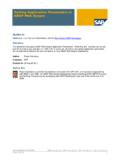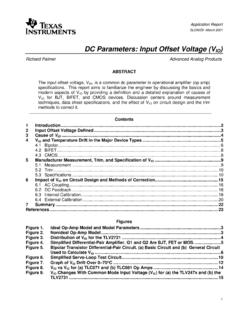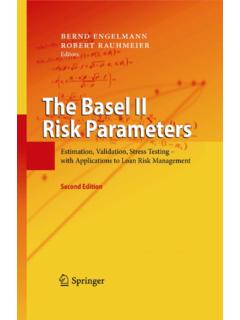Transcription of bk1 - Rutgers University
1 Scattering ParametersLinear two-port (and multi-port) networks are characterized by a number of equivalentcircuit parameters , such as their transfer matrix, impedance matrix, admittance matrix,and scattering matrix. Fig. shows a typical two-port matrix, also known as the ABCD matrix, relates the voltage and currentat port 1 to those at port 2, whereas theimpedance matrixrelates the two voltagesV1,V2to the two currentsI1,I2: V1I1 = ABCD V2I2 (transfer matrix) V1V2 = Z11Z12Z21Z22 I1 I2 (impedance matrix)( )Thus, the transfer and impedance matrices are the 2 2 matrices:T= ABCD ,Z= Z11Z12Z21Z22 ( )Theadmittance matrixis simply the inverse of the impedance matrix,Y=Z 1. Thescattering matrixrelates theoutgoingwavesb1,b2to theincomingwavesa1,a2thatareincidenton the two-port: In the figure,I2flows out of port 2, and hence I2flows into it.
2 In the usual convention, both currentsI1,I2are taken to flow into their respective S- parameters b1b2 = S11S12S21S22 a1a2 ,S= S11S12S21S22 (scattering matrix)( )The matrix elementsS11,S12,S21,S22are referred to as thescattering parametersortheS- parameters . The parametersS11,S22have the meaning of reflection coefficients,andS21,S12, the meaning of transmission many properties and uses of theS- parameters in applications are discussedin [1135 1174]. One particularly nice overview is the HP application note AN-95-1 byAnderson [1150] and is available on the web [1847].We have already seen several examples of transfer, impedance, and scattering ma-trices. Eq. ( ) or ( ) is an example of a transfer matrix and ( ) is thecorresponding impedance matrix. The transfer and scattering matrices of multilayerstructures, Eqs. ( ) and ( ), are more complicated traveling wave variablesa1,b1at port 1 anda2,b2at port 2 are defined in termsofV1,I1andV2,I2and a real-valued positive reference impedanceZ0as follows:a1=V1+Z0I12 Z0b1=V1 Z0I12 Z0a2=V2 Z0I22 Z0b2=V2+Z0I22 Z0(traveling waves)( )The definitions at port 2 appear different from those at port 1, but they are reallythe same if expressed in terms of the incoming current I2:a2=V2 Z0I22 Z0=V2+Z0( I2)2 Z0b2=V2+Z0I22 Z0=V2 Z0( I2)2 Z0 The termtraveling wavesis justified below.
3 Eqs. ( ) may be inverted to expressthe voltages and currents in terms of the wave variables:V1= Z0(a1+b1)I1=1 Z0(a1 b1)V2= Z0(a2+b2)I2=1 Z0(b2 a2)( )In practice, the reference impedance is chosen to beZ0=50 ohm. At lower fre-quencies the transfer and impedance matrices are commonly used, but at microwavefrequencies they become difficult to measure and therefore, the scattering matrix de-scription is can be measured by embedding the two-port network (the device-under-test, or, DUT) in a transmission line whose ends are connected to a network ana-lyzer. Fig. shows the experimental typical network analyzer can measureS- parameters over a large frequency range,for example, the HP 8720D vector network analyzer covers the range from 50 MHz Scattering Parameters66540 GHz. Frequency resolution is typically 1 Hz and the results can be displayed eitheron a Smith chart or as a conventional gain versus frequency under test connected to network shows more details of the connection.
4 The generator and load impedancesare configured by the network analyzer. The connections can be reversed, with thegenerator connected to port 2 and the load to port network under two line segments of lengthsl1,l2are assumed to have characteristic impedanceequal to the reference impedanceZ0. Then, the wave variablesa1,b1anda2,b2arerecognized as normalized versions of forward and backwardtraveling waves. Indeed,according to Eq. ( ), we have:a1=V1+Z0I12 Z0=1 Z0V1+b1=V1 Z0I12 Z0=1 Z0V1 a2=V2 Z0I22 Z0=1 Z0V2 b2=V2+Z0I22 Z0=1 Z0V2+( )Thus,a1is essentially the incident wave at port 1 andb1the corresponding reflectedwave. Similarly,a2is incident from the right onto port 2 andb2is the reflected wavefrom port network analyzer measures the wavesa 1,b 1anda 2,b 2at the generator andload ends of the line segments, as shown in Fig. From these, the waves at theinputs of the two-port can be determined.
5 Assuming lossless segments and using thepropagation matrices ( ), we have:66614. S- parameters a1b1 = e j 100ej 1 a 1b 1 , a2b2 = e j 200ej 2 a 2b 2 ( )where 1= lland 2= l2are the phase lengths of the segments. Eqs. ( ) can berearranged into the forms: b1b2 =D b 1b 2 , a 1a 2 =D a1a2 ,D= ej 100ej 2 The network analyzer measures the correspondingS- parameters of the primed vari-ables, that is, b 1b 2 = S 11S 12S 21S 22 a 1a 2 ,S = S 11S 12S 21S 22 (measuredS-matrix)( )TheS-matrix of the two-port can be obtained then from: b1b2 =D b 1b 2 =DS a 1a 2 =DS D a1a2 S=DS Dor, more explicitly, S11S12S21S22 = ej 100ej 2 S 11S 12S 21S 22 ej 100ej 2 = S 11e2j 1S 12ej( 1+ 2)S 21ej( 1+ 2)S 22e2j 2 ( )Thus, changing the points along the transmission lines at which theS-parametersare measured introduces only phase changes in the loss of generality, we may replace the extended circuit of Fig.
6 With theone shown in Fig. with the understanding that either we are using the extendedtwo-port parametersS , or, equivalently, the generator and segmentl1have been re-placed by their Th evenin equivalents, and the load impedance has been replaced by itspropagated version to network connected to generator and Power Flow667 The actual measurements of theS- parameters are made by connecting to a matchedload,ZL=Z0. Then, there will be no reflected waves from the load,a2=0, and theS-matrix equations will give:b1=S11a1+S12a2=S11a1 S11=b1a1 ZL=Z0=reflection coefficientb2=S21a1+S22a2=S21a1 S21=b2a1 ZL=Z0=transmission coefficientReversing the roles of the generator and load, one can measure in the same way Power FlowPower flow into and out of the two-port is expressed very simply in terms of the travelingwave amplitudes. Using the inverse relationships ( ), we find:12Re[V 1I1]=12|a1|2 12|b1|2 12Re[V 2I2]=12|a2|2 12|b2|2( )The left-hand sides represent the power flowintoports 1 and 2.
7 The right-hand sidesrepresent the difference between the power incident on a port and the power reflectedfrom it. The quantity Re[V 2I2]/2 represents the power transferred to the way of phrasing these is to say that part of the incident power on a portgets reflected and part enters the port:12|a1|2=12|b1|2+12Re[V 1I1]12|a2|2=12|b2|2+12Re[V 2( I2)]( )One of the reasons for normalizing the traveling wave amplitudes by Z0in thedefinitions ( ) was precisely this simple way of expressing the incident and reflectedpowers from a the two-port is lossy, the power lost in it will be the difference between the powerentering port 1 and the power leaving port 2, that is,Ploss=12Re[V 1I1] 12Re[V 2I2]=12|a1|2+12|a2|2 12|b1|2 12|b2|2 Noting thata a=|a1|2+|a2|2andb b=|b1|2+|b2|2, and writingb b=a S Sa,we may express this relationship in terms of the scattering matrix:Ploss=12a a 12b b=12a a 12a S Sa=12a (I S S)a( )66814.
8 S-ParametersFor a lossy two-port, the power loss is positive, which implies that the matrixI S Smust be positive definite. If the two-port is lossless,Ploss=0, theS-matrix will beunitary, that is,S S= already saw examples of such unitary scattering matrices in the cases of the equaltravel-time multilayer dielectric structures and their equivalent quarter wavelength mul-tisection Parameter ConversionsIt is straightforward to derive the relationships that allow one to pass from one param-eter set to another. For example, starting with the transfer matrix, we have:V1=AV2+BI2I1=CV2+DI2 V1=A 1CI1 DCI2 +BI2=ACI1 AD BCCI2V2=1CI1 DCI2 The coefficients ofI1,I2are the impedance matrix elements. The steps are reversible,and we summarize the final relationships below:Z= Z11Z12Z21Z22 =1C AAD BC1D T= ABCD =1Z21 Z11Z11Z22 Z12Z211Z22 ( )We note the determinants det(T)=AD BCand det(Z)=Z11Z22 Z12Z21.
9 Therelationship between the scattering and impedance matrices is also straightforward toderive. We define the 2 1 vectors:V= V1V2 ,I= I1 I2 ,a= a1a2 ,b= b1b2 ( )Then, the definitions ( ) can be written compactly as:a=12 Z0(V+Z0I)=12 Z0(Z+Z0I)Ib=12 Z0(V Z0I)=12 Z0(Z Z0I)I( )where we used the impedance matrix relationshipV=ZIand defined the 2 2 unitmatrixI. It follows then,12 Z0I=(Z+Z0I) 1a b=12 Z0(Z Z0I)I=(Z Z0I)(Z+Z0I) 1aThus, the scattering matrixSwill be related to the impedance matrixZbyS=(Z Z0I)(Z+Z0I) 1 Z=(I S) 1(I+S)Z0( ) Input and Output Reflection Coefficients669 Explicitly, we have:S= Z11 Z0Z12Z21Z22 Z0 Z11+Z0Z12Z21Z22+Z0 1= Z11 Z0Z12Z21Z22 Z0 1Dz Z22+Z0 Z12 Z21Z11+Z0 whereDz=det(Z+Z0I)=(Z11+Z0)(Z22+Z0) Z12Z21. Multiplying the matrixfactors, we obtain:S=1Dz (Z11 Z0)(Z22+Z0) Z12Z212Z12Z02Z21Z0(Z11+Z0)(Z22 Z0) Z12Z21 ( )Similarly, the inverse relationship gives:Z=Z0Ds (1+S11)(1 S22)+S12S212S122S21(1 S11)(1+S22)+S12S21 ( )whereDs=det(I S)=(1 S11)(1 S22) S12S21.
10 Expressing the impedance param-eters in terms of the transfer matrix parameters , we also find:S=1Da A+BZ0 CZ0 D2(AD BC)2 A+BZ0 CZ0+D ( )whereDa=A+BZ0+CZ0+ Input and Output Reflection CoefficientsWhen the two-port is connected to a generator and load as in Fig. , the impedanceand scattering matrix equations take the simpler forms:V1=ZinI1V2=ZLI2 b1= ina1a2= Lb2( )whereZinis the input impedance at port 1, and in, Lare the reflection coefficients atport 1 and at the load: in=Zin Z0 Zin+Z0, L=ZL Z0ZL+Z0( )The input impedance and input reflection coefficient can be expressed in terms oftheZ- andS- parameters , as follows:67014. S-ParametersZin=Z11 Z12Z21Z22+ZL in=S11+S12S21 L1 S22 L( )The equivalence of these two expressions can be shown by using the parameterconversion formulas of Eqs. ( ) and ( ), or they can be shown indirectly, asfollows.










